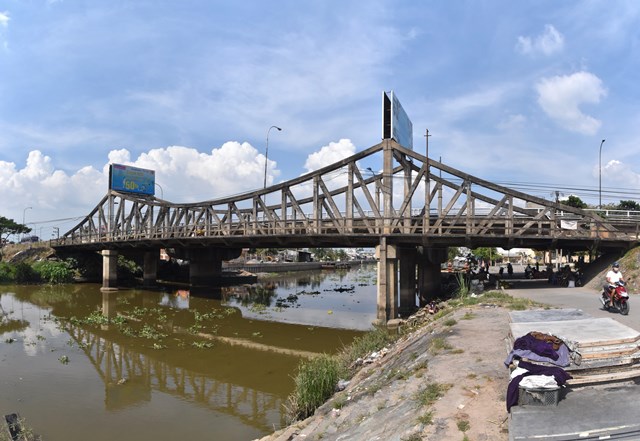We Recommend:
Bach Steel - Experts at historic truss bridge restoration.
BridgeHunter.com Phase 1 is released to the public! - Visit Now
Cầu Cai Lậy (Cai Lay Bridge)

Primary Photographer(s): Nathan Holth
Bridge Documented: December 6, 2018
Old QL-1 (đường Quốc Lộ 1 cũ) Over Ba Rai River (Sông Ba Rai)
Cai Lậy: Tiền Giang Province (Tỉnh Tiền Giang): Vietnam (Việt Nam)
By Builder/Contractor: Unknown
Not Available or Not Applicable
100.0 Feet (30.5 Meters)
185.0 Feet (56.4 Meters)
16 Feet (4.88 Meters)
3 Main Span(s)
Not Applicable

View Information About HSR Ratings
Bridge Documentation
Very little is known about this bridge and its history. The bridge lengths and widths given are very rough guesses. This concrete truss bridge has the shape and appearance of a cantilever truss bridge, but it is perhaps better described as a continuous truss bridge. A new bridge immediately north of this bridge today bypasses the historic bridge and carries the main highway. However, the bridge carries motorbike traffic and other forms of light vehicles, and connects the new high-level bridge to a road that goes under the bridge, and also provides connectivity to roads that run along the river which do not intersect with the new bridge. Thus, the bridge still retains a functional use and has not been simply abandoned.
Concrete truss bridges are one of the most rare bridge types in the world. Concrete simply never became a popular material for constructing truss bridges. Continuous and/or cantilever concrete truss bridges are an even more rare subcategory of concrete truss bridge. There are at least three bridges of this type that have been built in Vietnam. One was destroyed with some remnants surviving today. Another, Cầu Sêrêpốk crosses the Srepok River between Đắk Nông Province and Đắk Lắk Province. Unidentified historical photos further suggest there was at least one more bridge in addition to these three, and it is quite likely there may be more unaccounted examples, which may or may not survive today. Although all three bridges noted above are rare examples of continuous concrete truss bridges, the exact design details of each of these bridges varies, meaning these were not a "standard" bridge design in Vietnam. In any case, each surviving bridge is a rare and highly significant historic bridge, a bridge type that many countries do not have a single example of.
![]()
Photo Galleries and Videos: Cầu Cai Lậy (Cai Lay Bridge)
Bridge Photo-Documentation
Original / Full Size PhotosA collection of overview and detail photos. This gallery offers photos in the highest available resolution and file size in a touch-friendly popup viewer.
Alternatively, Browse Without Using Viewer
![]()
Bridge Photo-Documentation
Mobile Optimized PhotosA collection of overview and detail photos. This gallery features data-friendly, fast-loading photos in a touch-friendly popup viewer.
Alternatively, Browse Without Using Viewer
![]()
Maps and Links: Cầu Cai Lậy (Cai Lay Bridge)
Coordinates (Latitude, Longitude):
Search For Additional Bridge Listings:
Additional Maps:
Google Streetview (If Available)
GeoHack (Additional Links and Coordinates)
Apple Maps (Via DuckDuckGo Search)
Apple Maps (Apple devices only)
Android: Open Location In Your Map or GPS App
Flickr Gallery (Find Nearby Photos)
Wikimedia Commons (Find Nearby Photos)
Directions Via Sygic For Android
Directions Via Sygic For iOS and Android Dolphin Browser

